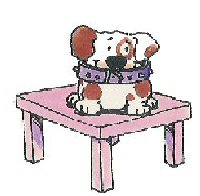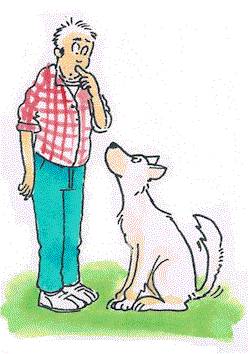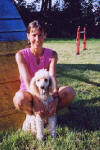Some things you should
consider...
 Your
dog can jump onto the chair, climb onto the kitchen table and, from there, he can leap into the
sink. Why? So the he can lick the remains of last night's dinner off the plates that you were
too tired to wash up before going to bed. Does that make him an agility dog? Good question.
He's pretty athletic, quite ingenious and he is certainly motivated by food. On the other hand,
he has no manners and lacks basic training! It's a clear cut choice between being a canine
dishwasher or an agility dog. Go for agility dog (more hygienic). Seriously, before you start
your lessons, there are some things you need to know says Mary Ann Nester. Your
dog can jump onto the chair, climb onto the kitchen table and, from there, he can leap into the
sink. Why? So the he can lick the remains of last night's dinner off the plates that you were
too tired to wash up before going to bed. Does that make him an agility dog? Good question.
He's pretty athletic, quite ingenious and he is certainly motivated by food. On the other hand,
he has no manners and lacks basic training! It's a clear cut choice between being a canine
dishwasher or an agility dog. Go for agility dog (more hygienic). Seriously, before you start
your lessons, there are some things you need to know says Mary Ann Nester.
The only way to find out if your dog
has got what it takes to do agility is to have a go. Dogs that don't love agility are few and
far between and to keep it that way, it's important to start right. Find a good agility club
where experienced instructors can teach you everything you need to know. Learn on new tricks in
a controlled environment that facilitates good training practice on agility equipment that
meets safety criteria. To locate a club near you with a beginner‘s class, look on the
Agilitynet list and choose a few to contact. Give them a ring and have a chat or arrange a
visit to watch a training session. There will be questions on both sides.
 What
THEY will ask you... What
THEY will ask you...
1. How old is your dog?
Would you expect a
toddler to be able to run a marathon? No. And puppies are too weenie to get over
full height jumps. The age that a club will accept a dog will vary from six months upward.
Most ask that a dog to be at least a year old or has finished growing. This ensures that the
dog has the strength and co-ordination to perform the equipment competently and the stamina
to last through a class. It also minimizes the risk of injury. Falling off the dog walk
is no fun.
2. Has your dog got basic
obedience?
The basic building blocks of agility are simple control exercises like 'sit', 'down' and
'come'. You can expect to do some of your initial agility training with your dog on the lead,
but it will soon go. Agility is a hands-free, off-lead sport. You don't want to arrive for
your first lesson and watch your dog disappear down a rabbit hole only to reappear at the end
of the lesson. In addition, if you have already establishing a working partnership with your
dog (I command, you do, I give you treat/toy/cuddle), you can apply this to agility
and speed up the learning process. Your dog will already know that there are lots of titbits
in your pocket and will be eager to find out what he has to do to get them.
3. Are you fit and well?
Starting an agility course in the last month of your pregnancy is not a good idea. Wait till
after the baby is born. Everyone can do agility and adjustments can be made if you aren't one
hundred per cent. If you have a hearing impairment, tell your instructor so that he can make
sure he is facing you when he speaks. If you have back problems, tell him and he will stop
shouting at you to run faster. There are people that compete in agility from a wheel chair.
Tell your instructor if you have a disability or medical condition and he can take it into
account in his lesson plan. In addition, he won't insist you lug heavy equipment back and
forth during course changes.
4. Is your pet fit and well?
If your dog has just
had puppies, is in season or is infectious with kennel cough, it would be wise to wait a
little longer till you start classes. Some disabilities or medical conditions will rule out
agility, but others can be accommodated. Don't delay explaining to your instructor that your
dog is deaf. He won't be able to tell by looking at it and the sooner he knows, the sooner he
can customize your dog's training.
5. Does your dog have any
behaviour problems?
Behaviour problems can be very disruptive for you, the class and your instructor. For
example, not all dogs allow their owners to handle them and some bark and snap if another
dogs gets too close to them. A good instructor will be keen to help you and may suggest
private lessons to iron out things before you throw yourself into a class situation. He might
welcome you into the class but ask your fellow students to keep their distance. If the
problem is severe or unmanageable, he would advise you to ask your vet to refer you to a
canine behaviourist before you try agility.
 What
YOU should ask them... What
YOU should ask them...
1.
When do you train?
It is no good signing
up for a class on a Tuesday night if you can't face missing 'Holby City'. If the class
finishes at 10.00 pm and you have a 45 minute drive home, do you really want to be up that
late when you start work at 7.00am the next day? Classes can be held during the day, in the
evenings or at week-ends. Find one that fits in with your timetable and you will find it easy
to attend.
2. Where is your venue?
Although the club might be named after your nearest village, their training venue might be
sixty miles down the road. You also want to find out if training is indoor or outdoors.
Outdoor venues can become quagmires in winter and you will need your waterproofs if it rains.
If on a farm, the flock a sheep in the neighbouring field can be an appreciative audience but
too much of a distraction for your dog if he is a baa-baa chaser. Many agility clubs hire
indoor riding schools for training classes. Perfect for the dog that is prone to doing a
runner because you can shut the doors; however, the flooring can be a bit tempting for those
dogs that like digging holes or eating horse manure.
3. What parking is available?
Is the parking near the venue and is there hard standing? Parking in the middle of a
field will mean a few more trips to the car wash and be prepared to get stuck in the mud at
least once.
4. Are there toilets?
This is very important question for you and your dog. I got lost finding a venue. It took me
two hours to locate. By the time I arrived, I was crossing my legs and there was nowhere to
uncross them. And worse, my dogs refused to squat on the 2 inch square piece of grass in the
car park. Some venues boast large exercise areas for the dogs, but don't count on it.
5. How many dogs are there in a
class?
Usually the fewer the dogs, the better. You will get more individual attention. Class size will vary,
but average is 8-10. Anymore and you could spend more time watching rather than doing agility.
It's worth thinking about class composition, too. If you have a tiny Yorkshire terrier, you
may feel more comfortable in a class composed of other small breeds and some clubs offer
'mini' dog classes. The only way to find out is to ask.
6. Are there other classes?
Few people give up agility once they have started. It's addictive. When you have finished
your introduction course, where to next? You'd like to advance up a level and try
something a little bit more difficult. Does the club have a system of progression? The
larger the club membership, the more likely there is to be a choice of different classes and
greater number of instructors, but size isn't everything. Smaller clubs can be more relaxed
and intimate. Some people prefer to remain with an instructor with whom they have established
a rapport rather than changing as they improve.
7. Are the instructors
qualified?
All instructors love dogs and want to do their best for you and your pet. They may be Agility
Club Approved, members of the Association of Pet Dog Trainers or Crufts' Agility finalists.
They may or may not have public liability cover (and many don't). Your instructor may be
another club member who started in the beginners class just like you. Qualifications and
experience count for a lot, but they are not the be all and end all. What is important is
your instructor's ability to communicate the fun of agility to you and your dog.
8. Is the club registered with
the Kennel Club?
If it is, it will be subject to the rules and regulations of the Kennel Club (KC). There will
be a committee who make all the important decisions and it‘s likely that they will hold a KC
licensed agility show each year. Members may be expected to help run things; for example,
working on a ring. At the other end of the continuum are the private clubs. They are the
responsibility of whoever started them. It may be an agility handler who hires a field for
his own use and subsidizes his hobby by offering classes to friends or an agility handlers
who runs the club as a businesses enterprise (membership and popularity can outstrip many of
the KC Clubs). Don't be surprised if you learn that the agility handler who teaches at his
own private club trains his own dogs at a KC registered club. Many people mix and match.
9. Is the emphasis of the club
competitive or recreational?
All agility clubs are fun, but some have a specialised membership. Some clubs only admit
competing dogs. They concentrate on more advanced training skills, league tables and the
important finals. Other clubs focus on recreational (not for competition) agility and staging agility displays at
the local fetes. And there are clubs that cater for both. The trick is to find one that suits
you!
10. How much will it cost?
Your choice of agility club must suit your pocket. And remember that the most expensive
classes won't necessarily be the best. There are a number of charging systems - pay as you
go, pay for a course of six lessons or pay a single lump sum for the year. And you may be
asked to pay a membership fee as well as class subscriptions.
What should you bring to your first class.
Most important, yourself
and the dog. Don't leave your dog's favourite treats/toys at home. Some clubs provide diced
cheese or liver cake at the first class, but not all. You should be told what sort of collar
and lead your dog should wear and to bring poo bags to clean up after your dog if he has an
accident. Be prepared and ask what clothing and footwear to don at your agility debut. You
don't want to be the sad woman in the mini skirt and heels trying to keep up with the
greyhound.
Don't stop at asking questions.
Reconnoitre!
If you have the time,
visit an agility club before you sign up for lessons. Look at the dogs. Do they look like they
are having fun? Look at the handlers. Do they look like they are having fun? Look
at the instructor. Does he still have all his hair or is he pulling it out by the handful in
frustration? Look at the equipment. Is the A-frame in danger of disintegration the next
time a dog puts his toe on it? If you like what you see, sign your name on the bottom
line and start training.
Remember!
You can ask all the right
questions and still end up at the wrong club. You fall out with another student or the journey
there takes longer than you anticipated. Don't worry! There's another agility club round
the corner for you to try out. You now not only know the questions to ask, but the right
answers for you and your dog!
 About
the author... About
the author...
Mary Ann Nester
was born in the USA and came to Britain in 1972 as a student. In 1997 she set up Aslan Dog
Training Club, named after her Lurcher and first agility dog.
Mary Ann's most successful agility
dogs have been miniature poodles. Brillo Pad competed in the Draw Challenge on National Lottery
Live!, winning Mary Ann the privilege of pushing the button that released the evening's lottery
balls in front of millions of television viewers. None of her friends had a winning ticket but
it was good PR for poodles. In addition, Brillo and Daz have both been finalists at Olympia and
Crufts and have competed at international level. Brillo represented Great Britain at the World
Agility Championships in 2001 and Daz in 2002 and 2003.
She now lives in Northamptonshire
and combines dog training and writing with working as a receptionist at a veterinary surgery.
With five dogs of various ages and degrees of decrepitude, she needs the staff discount to keep
them in tablets.
Cartoons by
Kim
Blundell / Roo Roo Design
|